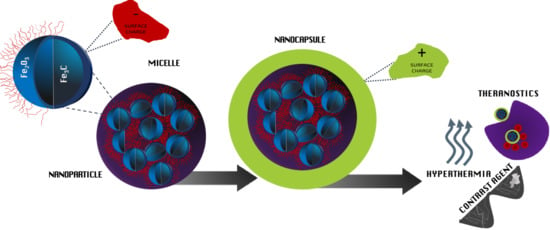Micelle Encapsulation of Ferromagnetic Nanoparticles of Iron Carbide@Iron Oxide in Chitosan as Possible Nanomedicine Agent
Abstract
:1. Introduction
2. Materials and Methods
2.1. Materials
2.1.1. Iron Carbide@Iron Oxide Nanoparticles (ICIONPs)
2.1.2. Nanoemulsion and Nanoparticles
2.1.3. Nanocapsules Fabrication
2.2. Characterization
2.2.1. Scanning and Transmission Electron Microscopy
2.2.2. Dynamic Light Scattering and Laser Doppler Electrophoresis
2.2.3. FTIR Spectroscopy
3. Results and Discussions
3.1. Scanning and Transmission Electron Microscopy
3.2. Dynamic Light Scattering
3.3. Laser Doppler Electrophoresis
3.4. FTIR Spectra
4. Conclusions
Author Contributions
Funding
Acknowledgments
Conflicts of Interest
References
- Ratner, B.D.; Hoffman, A.S.; Schoen, F.J.; Lemons, J.E. Biomaterials Science: An Introduction to Materials in Medicine; Academic Press: San Diego, CA, USA, 2012; ISBN 008087780X. [Google Scholar]
- Múzquiz-Ramos, E.M.; Guerrero-Chávez, V.; Macías-Martínez, B.I.; López-Badillo, C.M.; García-Cerda, L.A. Synthesis and characterization of maghemite nanoparticles for hyperthermia applications. Ceram. Int. 2014, 41, 397–402. [Google Scholar] [CrossRef]
- Serna, C.J.; Morales, M.P. Maghemite (γ-Fe2O3): A Versatile Magnetic Colloidal Material; Springer: Boston, MA, USA, 1988; Volume 27, ISBN 978-3-540-21247-8. [Google Scholar]
- Hong, R.Y.; Zhang, S.Z.; Di, G.Q.; Li, H.Z.; Zheng, Y.; Ding, J.; Wei, D.G. Preparation, characterization and application of Fe3O4/ZnO core/shell magnetic nanoparticles. Mater. Res. Bull. 2008, 43, 2457–2468. [Google Scholar] [CrossRef]
- Sun, J.; Zhou, S.; Hou, P.; Yang, Y.; Weng, J.; Li, X.; Li, M. Synthesis and characterization of biocompatible Fe3O4 nanoparticles. J. Biomed. Mater. Res. Part A 2007, 80, 333–341. [Google Scholar] [CrossRef] [PubMed]
- Lindemann, A.; Pries, R.; Ludtke-Buzug, K.; Wollenberg, B. Biological Properties of Superparamagnetic Iron Oxide Nanoparticles. IEEE Trans. Magn. 2015, 51, 1–4. [Google Scholar] [CrossRef]
- Kita, E.; Oda, T.; Kayano, T.; Sato, S.; Minagawa, M.; Yanagihara, H.; Kishimoto, M.; Mitsumata, C.; Hashimoto, S.; Yamada, K.; et al. Ferromagnetic nanoparticles for magnetic hyperthermia and thermoablation therapy. J. Phys. D. Appl. Phys. 2010, 43, 474011. [Google Scholar] [CrossRef]
- Pearce, J.A.; Cook, J.R.; Emelianov, S.Y. Ferrimagnetic Nanoparticles Enhance Microwave Heating for Tumor Hyperthermia Therapy. In Proceedings of the 2010 Annual International Conference of the IEEE Engineering in Medicine and Biology, Buenos Aires, Argentina, 31 August–4 September 2010; pp. 2751–2754. [Google Scholar]
- Ren, X.; Chen, H.; Yang, V.; Sun, D. Iron oxide nanoparticle-based theranostics for cancer imaging and therapy. Front. Chem. Sci. Eng. 2014, 8, 253–264. [Google Scholar] [CrossRef]
- Laurent, S.; Forge, D.; Port, M.; Roch, A.; Robic, C.; Vander Elst, L.; Muller, R.N. Magnetic Iron Oxide Nanoparticles: Synthesis, Stabilization, Vectorization, Physicochemical Characterizations, and Biological Applications. Chem. Rev. 2008, 108, 2064–2110. [Google Scholar] [CrossRef] [PubMed]
- Hormes, J.; Leuschner, C. Nanofabrication Towards Biomedical Applications; John Wiley & Sons: Hoboken, NJ, USA, 2005; ISBN 9783527603473. [Google Scholar]
- Ling, D.; Lee, N.; Hyeon, T. Chemical Synthesis and Assembly of Uniformly Sized Iron Oxide Nanoparticles for Medical Applications. Acc. Chem. Res. 2015, 48, 1276–1285. [Google Scholar] [CrossRef] [PubMed]
- Banerjee, H.N.; Verma, M. Application of Nanotechnology in Cancer. Res. J. Pharm. Technol. 2012, 5, 1161–1167. [Google Scholar] [CrossRef] [PubMed] [Green Version]
- Kothamasu, P.; Kanumur, H.; Ravur, N.; Maddu, C.; Parasuramrajam, R.; Thangavel, S. Nanocapsules: The weapons for novel drug delivery systems. Bioimpacts 2012, 2, 71–81. [Google Scholar] [CrossRef] [PubMed]
- Spernath, L.; Magdassi, S. Polyurea nanocapsules obtained from nano-emulsions prepared by the phase inversion temperature method. Polym. Adv. Technol. 2011, 22, 2469–2473. [Google Scholar] [CrossRef]
- Argüelles-Pesqueira, A.I.; Diéguez-Armenta, N.M.; Bobadilla-Valencia, A.K.; Nataraj, S.K.; Rosas-Durazo, A.; Esquivel, R.; Alvarez-Ramos, M.E.; Escudero, R.; Guerrero-German, P.; Lucero-Acuña, J.A.; et al. Low intensity sonosynthesis of iron carbide@iron oxide core-shell nanoparticles. Ultrason. Sonochem. 2018, 49, 303–309. [Google Scholar] [CrossRef] [PubMed]
- Rosas-Durazo, A.; Lizardi, J.; Higuera-Ciapara, I.; Argüelles-Monal, W.; Goycoolea, F.M. Development and characterization of nanocapsules comprising dodecyltrimethylammonium chloride and κ-carrageenan. Colloids Surf. B Biointerfaces 2011, 86, 242–246. [Google Scholar] [CrossRef] [PubMed]
- Cheng, F.Y.; Su, C.H.; Yang, Y.S.; Yeh, C.S.; Tsai, C.Y.; Wu, C.L.; Wu, M.T.; Shieh, D. Bin Characterization of aqueous dispersions of Fe3O4 nanoparticles and their biomedical applications. Biomaterials 2005, 26, 729–738. [Google Scholar] [CrossRef] [PubMed]
- Piehler, S.; Wucherpfennig, L.; Tansi, F.L.; Berndt, A.; Quaas, R.; Teichgraeber, U.K.; Hilger, I. Hyperthermia affects collagen fiber architecture and induces apoptosis in pancreatic and fibroblast tumor hetero-spheroids in vitro. Nanomed. Nanotechnol. Biol. Med. 2020, 102183. [Google Scholar] [CrossRef] [PubMed]
- Chen, L.; Mccrate, J.M.; Lee, J.C.-M.; Li, H. The role of surface charge on the uptake and biocompatibility of hydroxyapatite nanoparticles with osteoblast cells. Nanotechnology 2011, 22, 105708. [Google Scholar] [CrossRef] [PubMed] [Green Version]
- Rezwan, K.; Studart, A.R.; Vörös, J.; Gauckler, L.J. Change of ζ potential of biocompatible colloidal oxide particles upon adsorption of bovine serum albumin and lysozyme. J. Phys. Chem. B 2005, 109, 14469–14474. [Google Scholar] [CrossRef] [PubMed]





© 2020 by the authors. Licensee MDPI, Basel, Switzerland. This article is an open access article distributed under the terms and conditions of the Creative Commons Attribution (CC BY) license (http://creativecommons.org/licenses/by/4.0/).
Share and Cite
Sauceda-Oloño, P.Y.; Cardenas-Sanchez, H.; Argüelles-Pesqueira, A.I.; Gutierrez-Valenzuela, C.; Alvarez-Ramos, M.E.; Lucero-Acuña, A.; Zavala-Rivera, P. Micelle Encapsulation of Ferromagnetic Nanoparticles of Iron Carbide@Iron Oxide in Chitosan as Possible Nanomedicine Agent. Colloids Interfaces 2020, 4, 22. https://doi.org/10.3390/colloids4020022
Sauceda-Oloño PY, Cardenas-Sanchez H, Argüelles-Pesqueira AI, Gutierrez-Valenzuela C, Alvarez-Ramos ME, Lucero-Acuña A, Zavala-Rivera P. Micelle Encapsulation of Ferromagnetic Nanoparticles of Iron Carbide@Iron Oxide in Chitosan as Possible Nanomedicine Agent. Colloids and Interfaces. 2020; 4(2):22. https://doi.org/10.3390/colloids4020022
Chicago/Turabian StyleSauceda-Oloño, Perla Yazmin, Hector Cardenas-Sanchez, Anya Isabel Argüelles-Pesqueira, Cindy Gutierrez-Valenzuela, Mario Enrique Alvarez-Ramos, Armando Lucero-Acuña, and Paul Zavala-Rivera. 2020. "Micelle Encapsulation of Ferromagnetic Nanoparticles of Iron Carbide@Iron Oxide in Chitosan as Possible Nanomedicine Agent" Colloids and Interfaces 4, no. 2: 22. https://doi.org/10.3390/colloids4020022






